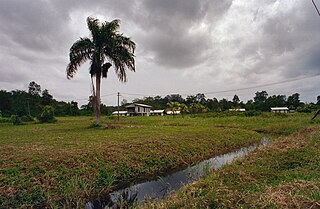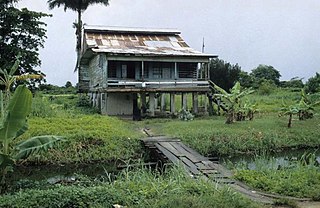
Commewijne is a district of Suriname, located on the right bank of the Suriname River. Commewijne's capital city is Nieuw Amsterdam. Tamanredjo is another major town, while Meerzorg is the most populated.
Prostitution in Suriname is illegal but widespread and the laws are rarely enforced. Human trafficking and Child prostitution are problems in the country. Prostitutes are known locally as "motyo". UNAIDS estimate there to be 2,228 prostitutes in the country.

Meerzorg is a town and resort (municipality) in Suriname, located on the eastern bank of the Suriname River, directly opposite the capital Paramaribo. Its population at the 2012 census was 12,405. Since 2000 it has been connected to Paramaribo by the Jules Wijdenbosch Bridge, named after the former President Jules Wijdenbosch.

Alkmaar is a resort in Suriname, located in the Commewijne District. Its population at the 2012 census was 5,561.

Johan & Margaretha or sometimes just Margaretha is a resort in Suriname, located in the Commewijne District. Its population at the 2012 census was 756. It is located along a peninsula northeast of Paramaribo. It is named after the coffee plantation Johan & Margaretha which was founded in 1745 by Johan Knöffel. It is safe to assume that his wife was called Margaretha.

Tamanredjo is a resort and town in Suriname, located in the Commewijne District. Its population at the 2012 census was 6,601.

Oostelijke Polders is a resort in Suriname located in the Nickerie District. Its population at the 2012 census was 7,153. Villages in the resort include Glasgow, Hamptoncourtpolder, and Paradise. Oostelijke Polders is an agricultural area with a focus on rice production. Oostelijke Polder has a clinic and a school.

Beekhuizen is a former sugarcane plantation and currently a resort in Suriname, located in the Paramaribo District. Its population at the 2012 census was 17,185.
Javanese Surinamese people are an ethnic group of Javanese descent in Suriname. They have been present since the late 19th century, when their first members were selected as indentured laborers by the Dutch colonizers from the former Dutch East Indies.

Mariënburg is a former sugarcane plantation, factory and village, situated in the district of Commewijne, in northern Suriname.

Surinam, also known as Dutch Guiana, was a Dutch plantation colony in the Guianas, neighboured by the equally Dutch colony of Berbice to the west, and the French colony of Cayenne to the east.

Elisabeth Samson (1715—1771) was an Afro-Surinamese coffee plantation owner. She was born in 1715 in Paramaribo to a freed slave, known as Mariana. All of her other siblings had been born as slaves and were emancipated by her half-brother Charlo Jansz. Raised in the home of her half-sister Maria Jansz, Samson was taught to read and write by her brothers-in law who also trained her in business. She began acquiring property at the age of 19, but was banished from the colony in 1736 after being convicted of slander. Her appeal, heard by the Dutch Parliament, was successful and she returned to Suriname in 1739.

Maxi Linder the alias used by Wilhelmina Rijburg (1902–1981) was a well-known and influential Surinamese prostitute. In her heydey, she had access to the highest social and political figures. She used her earnings to fund the education of disadvantaged youth and made the first attempt in the country to organize sex workers.

Berg en Dal is a village in the resort of Klaaskreek in the Brokopondo District of Suriname. The village is located on the Suriname River.

Bethesda was a Moravian leper colony from 1899 until 1933. The name refers to the healing of the paralytic at Bethesda by Jesus. The colony was located near Paranam in the Oost resort on the Suriname River. It was originally located on the former sugar plantation 'Great Chatillon', that already served as a leper colony of the Dutch colonial state. The Catholic leper colony 'Saint Gerardus Majella', founded in 1895 as successor of Batavia, was located nearby. In 1933 the Bethesda leper colony moved to Livorno, closer to the centre of Paramaribo, where it functioned as New Bethesda until 1964. Initially patient care at Bethesda was in the hands of German deaconesses. After the Second World War their leadership was taken over by the Dutch and the Surinamese.

Theresa Evelyne Leuwsha is a Surinamese Dutch writer.
The Brooskampers were a Maroon people, descendants of runaway African slaves, living in the forested interior of Suriname. The tribe is related to the Saramaka, and originated from Loango-Angola. The Brooskampers gained autonomy in 1863, but sold their land in 1917.

Berlijn is a village and former wood plantation in the resort of Zuid in the Para District in Suriname. It is located on the Para Creek, and about 4 kilometres (2.5 mi) from the Johan Adolf Pengel International Airport.

Onverdacht is a village in the resort of Zuid in the Para District of Suriname. Between 1941 and 2009, it was a bauxite mining town.

The history of Suriname during World War II was mainly focused on protecting the bauxite industry and guarding the borders with French Guiana which was part of Vichy France. From November 1941 onwards, 2,000 American troops were stationed in Suriname who transformed Airstrip Zanderij into a major airport, and constructed defensive works. No actual battles took place in Suriname. There was a political crisis in 1943, because Governor Johannes Kielstra used the state of emergency to imprison political opponents.


















